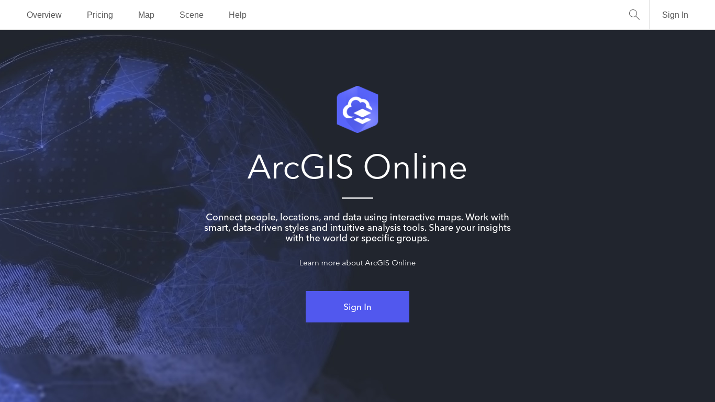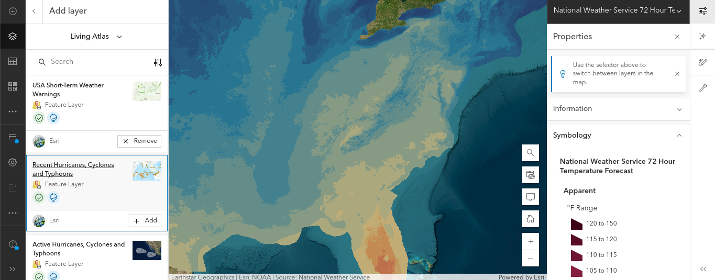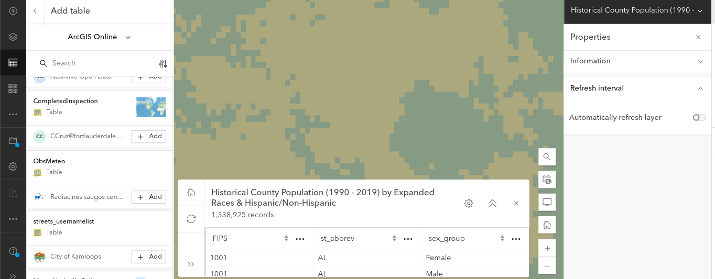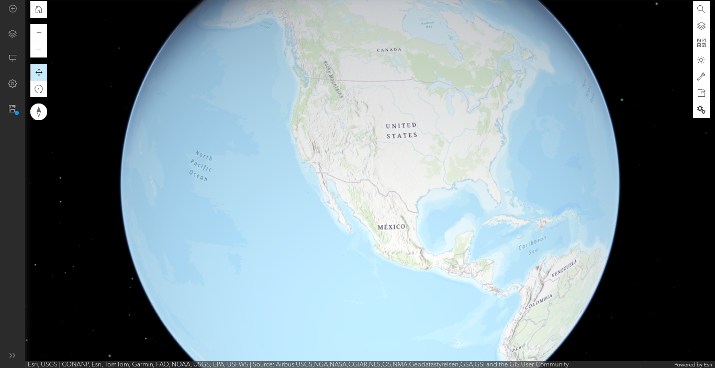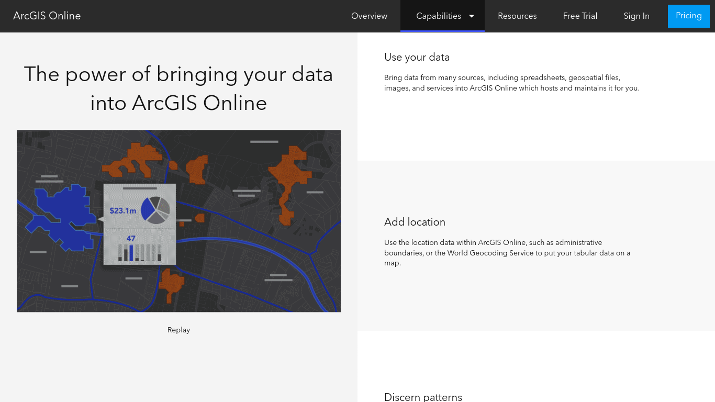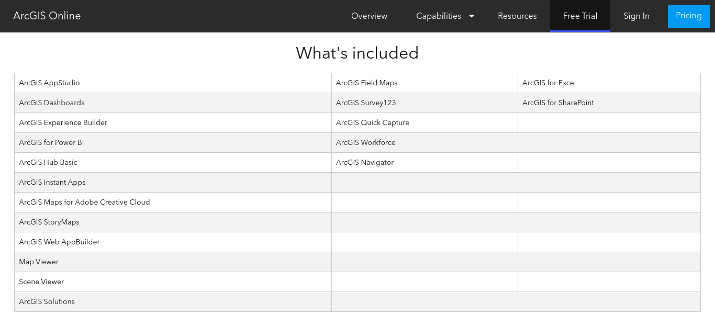ArcGIS Online is a web map from Esri (Environmental Systems Research Institute, Inc), which is a GIS (geographic information system) software company based in California.
It’s designed primarily for organizations and corporations, although you can use it for personal use as well.
In this ArcGIS Map review, I will go over various features of ArcGIS Online. If you’re wondering whether ArcGIS would be any good for you, keep on reading!
Also Read: Marble Review
Verdict
Our Rating: ⭐⭐⭐⭐✰
ArcGIS Online is a professional software suite that allows users to create maps and visualize data through layers, tables, and more. Users can share maps and collaborate with others.
It’s often used for research, city planning, gas line mapping, and other professional use cases. However, it can also be used for personal projects and hobbies.
Pros
- It’s one of the most advanced mapping software out there, offering a host of high-end and professional features.
- It can be used by professionals and individuals alike.
- A free trial is available.
- A host of layers and data is readily available from the databases.
Cons
- It can be quite expensive.
- For individuals simply interested in viewing satellite or weather maps, there are plenty of free options out there that are more suitable.
- The user interface is not intuitive and can be quite confusing to figure out.
Also Read: Nasa Worldview Review
ArcGIS Online Overview
ArcGIS Online is a web-based mapping application, offered as a SaaS (Software as a Service) to commercial users. You can use it to create maps and display data to your users.
It’s used extensively by local governments, including cities, for purposes such as road network planning. It’s also used for gas and electric line mapping, forestry mapping, aviation, and emergency response management (in other words, emergency response centers use it for planning optimized response times).
Many educational institutions also use ArcGIS Online for educational purposes. However, many individuals use it as well, and a personal license is provided for personal use.
It has extensive collaboration capabilities, allowing you to work together with your team and work on city plans and other projects.
ArcGIS Online also allows you to visualize and analyze data. It’s a powerful application, but it’s not free, although it does offer a free trial and limited licenses for personal and educational use.
Read on to learn more about it.
Check Out: Zoom Earth Review
Creating Maps on ArcGIS
ArcGIS allows you to create maps online. Your first step is choosing a base map, after which you can add layers of visualization.
You can then apply styles to your map and add pop-ups.
Base Maps
As you can see in the following screenshot, there are several types of base maps. Some display satellite imagery, others display topographic or street information, and yet others display a night view.
Check Out: Waze Map Alternatives
The choice is yours, depending on your needs. You can create a city street map or a terrain map, and you can even change the background color.
Layers
Once you’ve chosen your base map, you can add layers. Layers can come from several sources; if you don’t have any of your own, you can select layers from the ArcGIS Online or Living Atlas databases.
For example, as you can see in the following screenshot, here is a small sample of the layers you can find from the Living Atlas database:
- National Weather Service 72-Hour Temperature Forecast
- USA Short-Term Weather Warnings
- Recent Hurricanes, Cyclones, and Typhoons
- Recent Earthquakes
Check Out: Satellites Pro Review
All of those layers were created by Esri. However, the ArcGIS Online database has many contributors; here are some of the layers available from third parties:
- Alectra Outage Map
- Real_Time_Traffic_Volume_and_Speed_Current_All_Directions_TDA
- Ontario Trail Network (OTN) Access Point
Of course, as an organization, you can create your own map. Electric companies can create outage maps, while cellular companies can create coverage maps and provide that to customers.
ArcGIS Online is thus very customizable. If you’re an individual, you might be interested in various weather phenomena, and ArcGIS Online is perfect for that.
However, you might also be interested in creating other maps for personal use, such as trail hiking access points. It’s up to you.
Check Out: Best Google Earth Alternatives
Tables
You can also add tables to your maps. Once again, you can create your own tables or add those from one of the available databases.
For example, one interesting table you can add to your map from Living Atlas is “Historical County Population (1990–2019) by Expanded Races & Hispanic/Non-Hispanic.”
It provides historical data for US counties, breaking up county demographics based on race, sex, and Hispanic origin.
Another table, from the ArcGIS Online database, provides information on building violation liens in Miami-Dade County, with data provided by Miami-Dade County, Florida, regarding liens in the county.
Also Read: Best Zoom Earth Alternatives
Creating Scenes
In addition to creating maps, you can create “scenes.” Scenes are representations of geographic information and other data in 3D (three-dimensional), allowing you to create realistic visualizations from data.
In addition to 3D scenes on a globe, you can create local scenes, which display local data on a projected coordinate system. This option is best for visualizing local data important for your city.
As with maps, you can add layers to provide additional information in your scenes.
Furthermore, you can capture screenshots from your scenes at different points to create a slide presentation.
Check Out: Waze vs Apple Maps
Creating Web Apps
Once you have created a map, you can create a web app, so people can visit it online and view it. You can use ArcGIS Hub to create your own personalized branded website and web app, although there are various other available website builders as well.
Either way, you can configure your website and add functionalities, side-by-side map viewing, and other features for your visitors.
The following is a table displaying the various website builders you can use and their features.
Collaboration and Sharing
One of the best things about ArcGIS Online is that it makes collaboration easy. You can form groups, with layers, tables, and other data available to members of the group so they can add them when creating maps.
The account administrator decides which users have access to which data and which users can create or edit maps.
Collaboration allows emergency response teams across counties, for example, to work with the same data.
With administrative dashboards and batch workflows that allow you to manage accounts that have thousands of users, ArcGIS Online is perfect for large corporations, city governments, and other large organizations.
There are also highly customizable sharing options. You can share data and maps privately, within your organization, or with the public.
As mentioned, you can create your own web app with your maps. However, you can also embed your maps in your blog posts, websites, and social media posts.
Also Read: Google Earth vs Google Maps
Analyzing and Working With Data
ArcGIS Online offers powerful tools for working with data. You can import your organization’s data from spreadsheets, geospatial images, and other sources.
You can also add location data and put data from tables onto the map. Using predefined geographical filters, such as postal codes, you can break down your data by location or region.
Explore: Best Google Maps Alternatives
Pricing
ArcGIS Online offers flexible pricing, depending on your needs.
To start with, you can sign up for a 21-day free trial, during which you will have access to the ArcGIS Online suite of tools for free, for a limited time. Check the table below to see which features you get access to during your free trial.
What you get after that depends on which license you want to sign up for. Let’s go over some of the licenses and US pricing options available.
- Individuals: Individuals who want to use ArcGIS for personal use must pay $100/year. Commercial use is prohibited on this plan; you can only use for personal research, projects, and hobbies.
- Students: The student plan also costs $100/year. If you’re a student trying to build a portfolio while in school, this is the plan for you. Note that while features are mostly the same as the personal license, there are some slight variations.
- Creator: The Creator license for professionals, which allows you to create and share maps for commercial use, costs $550/year.
- Viewer: A professional Viewer license is a dependent license that requires someone in the team to have a Creator license. It allows the user to view maps and monitor project performance. It costs $110/year.
- Mobile Worker: Another dependent license, this license allows a team member to use apps to collect data and conduct surveys in the field. It costs $385/year.
- Editor: This is another dependent professional license. It costs $220/year and allows the user to edit maps and add data but not create maps.
Note that these licenses only cover ArcGIS Online. If you want ArcGIS Professional, which is the more powerful desktop application that allows you to combine 3D, CAD (Computer-Aided Design, often used by architects), and other imagery, prices start from $765/year and go up to $4,150/year, depending on your needs.
As always, check the pricing page for updated pricing information.
Check Out: Best MapQuest Alternatives
Conclusion
If you’re looking for a professional mapping software for research, personal projects, city planning, or corporate use, ArcGIS might be the right choice.
It’s one of the best software of its kind for its intended target audience.
However, if you’re simply interested in a satellite map or weather map you can view online, there are tons of free alternatives that don’t cost any money and which don’t involve a learning curve.
